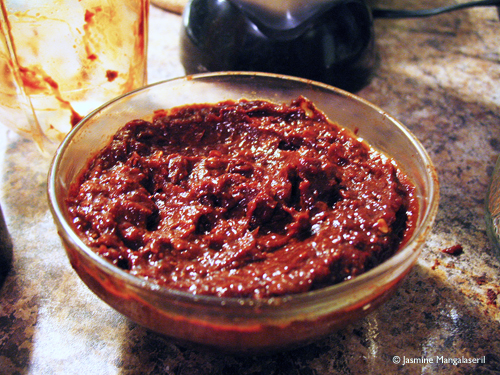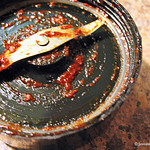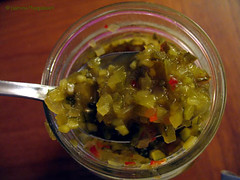
Let's just say these few years have been a bit of a whirlwind of change. From a new employer to being self-employed. From three furry and aged companions to two young and sprightly ones. From one less than stellar love match to another less than stellar love match. And while I spun about and danced on the latest gust of wind, my posts became perfunctory and infrequent. A glimpse here, a word there -- only a small number of recipes saw the bluey-white light of my screen, from the trove of potential posts that remain in my mind.
Today's post is one of those recipes that's lingered for months.
I noticed harissa began to pop up more frequently in ingredients lists, but like pretty much every other trend, I didn't pay much attention. It was the new sriracha, making it the new ketchup, making it relatively ubiquitous. At once it was commonplace and exotic. Without the time to research or make my own, I excelled at makeshift substitutions, cobbled together with what resided in my sticky-shelved pantry.
Eventually, I found a bottle of it in my swanky specialty shop of choice. I was disappointed. It was bitter and bland and bit oily, which belied its "spicy" label. I continued to use it, spiked with the same residents from my sticky-shelved pantry. The banal was made bearable.
Despite that rather disappointing introduction, I was determined to find out why so many people were enamoured with it. I found my inner Phryne and pored over books and articles. Unsurprisingly, unlike that little overpriced jar from California, real harissa is varied and complex. Like any homemade condiment, this chilli paste changes from cook to cook, some adding grilled capsicums, others use tomato passata, and still others include rosewater or citrus.
My version is a combination of Paula Wolfert's harous and Claudia Roden's harissa. The resulting vermillion paste has a pleasing and rounded heat. While I've been known to spoon a little as a condiment with my dinner, I also use it in marinades and mix it with mayonnaise for frites or beefy sandwiches. It keeps in the fridge for weeks.

Harissa
Adapted Claudia Roden's harissa recipe and Paula Wolfert's harous recipe.
Yield: approx 80ml (1/3c)
Ingredients
1 shallot, thinly sliced
Pinch Turmeric
1 dspn/2tsp 10ml salt, divided
50g (2oz) dried chillies (see notes)
1tsp 5ml whole coriander seed
1tsp 5ml whole caraway seed
1tsp 5ml whole cumin seed
2 garlic cloves
Pinch of cinnamon
2dspn/1-1/2Tbsp 40ml extra-virgin olive oil
Method
Combine shallot with turmeric and 1tsp salt. Cover with cling and let stand at room temperature for an hour (or up to overnight).
Dry toast the whole spices. Cool before grinding into a fine powder. Set aside.
Rehydrate chillies with boiling water for about 30-45 minutes, until they are soft and pliable. Drain, stem and deseed before giving them a coarse grind. Add the shallots (draining, if necessary) and garlic and continue grinding until smooth. Add the powdered spices, remaining teaspoon of salt and olive oil. Continue grinding until you have a smooth puree. Balance flavours to taste.
Notes
Choose whichever varietal you wish, or create your own blend from a mix of hot, sweet and smokey peppers. I used roughly equal weights of ancho, arbol, guajillo and pasilla chillies.
cheers!
jasmine
I'm a quill for hire!




